WRONG WITH THE WIND
09 November 2022
Scotland has substantial renewable energy resources, and that’s a very good thing. But hugely exaggerating the size of the potential resource for political purposes is not a good thing. This is the story of how the Scottish Government has for years been knowingly inflating Scotland's share of Europe's potential offshore wind resource.
A pdf version of this report can be downloaded here.
Executive Summary
“Scotland has 25% of Europe’s potential offshore wind resource.”
If you’ve been following Scottish politics over the last decade, you will certainly recognise the above claim.
Many people have raised an eyebrow at the figure. But until now it has gone largely unchallenged.
These Islands has painstakingly investigated its provenance, and uncovered a remarkable story:
-
The 25% claim is not true
-
The Scottish Government has attempted to justify it with obviously flawed calculations
-
The Scottish Government has known for some time that the claim cannot be justified, and yet the SNP continues to push it
-
A realistic figure is 4-6%
Freedom of Information responses reveal that not only has the Scottish Government been relying on data compiled nearly 30 years ago, it has been misusing that data to construct a fatally flawed “apples vs oranges” justification for the 25% claim.
In order to estimate Scotland’s share of the potential European resource, two different studies - conducted 8 years apart - were used for the numerator and denominator of the fraction.
Critically, the assumptions in the two studies are inconsistent - the denominator is based on far more conservative assumptions than the numerator.
The denominator also uses a definition of Europe which includes only 11 countries, and excludes Norway, Sweden, and Finland.
Freedom of Information requests have also uncovered that officials within the Scottish Government have known for years that the claim cannot be justified, and should not be used. This is how Scottish Government officials have been talking amongst themselves about the claim:
“Whilst the 25% figure has been used in the past, we tend not to use this anymore. It has proved very difficult to source.”
“the 25% estimate has never, to my knowledge, been properly sourced”
“Yes we did recycle those figures quite robotically without really checking them.”
A realistic, up-to-date, estimate of Scotland’s share of the potential European offshore wind resource is 4 – 6%. Still an impressive figure, but nowhere near the 25% which the Scottish Government has been claiming.
This report details the full story of how the Scottish Government came to overstate Scotland’s share of Europe’s offshore wind resource by around 5 times, and also explains how the calculation can be (and should have been) done correctly.
The Full Story
The claim that Scotland possesses 25% of Europe’s potential offshore wind resource first appeared in an official Scottish Government report in 2010.1Scotland's offshore wind route map: developing Scotland's offshore wind industry to 2020. Published by the Scottish Government. 28th September 2010
Alex Salmond had been pushing different versions of this statistic since at least 20062Salmond sets out Ambition for Supergrid Connection. Published by the SNP. 29th October 2006, but it wasn’t until the SNP was in government that it became an “official” Scottish Government statistic.
Salmond included the claim in his speech at the 2012 SNP Party Conference, and it went on to feature in Scotland’s Future (the “White Paper” manifesto for independence published before the 2014 referendum). It wasn't tucked away in a footnote:
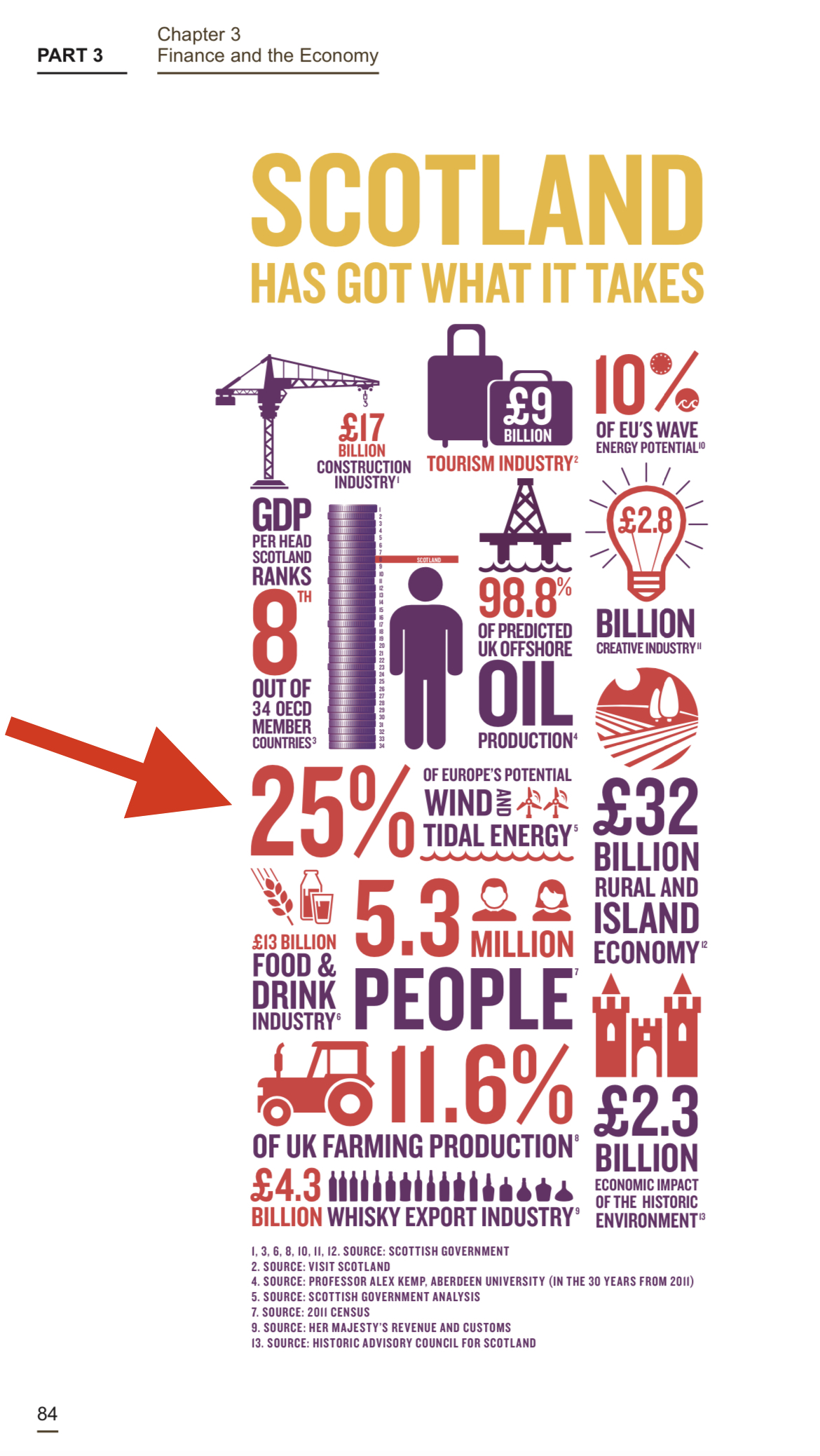
Since then it has become an SNP mantra: frequently cited in debates at Holyrood and the House of Commons, and a key message in campaigning material from the SNP, Yes Scotland, and Believe in Scotland.
In March 2022 the 25% claim was prominently cited in Cabinet Secretary for Finance and the Economy Kate Forbes’ National Strategy for Economic Transformation3Scotland's National Strategy for Economic Transformation. Published by the Scottish Government. 1st March 2022, and just last month it was heavily promoted in a report commissioned by Ian Blackford for the SNP Westminster Parliamentary Group.4Scotland can lead the green industrial revolution through independence, new report shows. Published by the SNP. 7th October 2022
Freedom of information requests and some old-fashioned detective work by These Islands have uncovered a remarkable story: the 25% claim is not true, and the Scottish Government has known for some time that it cannot be justified.
In January 2021 a Freedom of Information request was submitted to the Scottish Government asking how the 25% claim was justified. The response, published in March 2021, included this rather sheepish remark:5Scotland's percentage of Europe's offshore wind and tidal resources: EIR release. Published by the Scottish Government. 1st March 2021
“This is a dated but often used figure.”
To justify the 25% claim, the FOI response cited two separate reports, published in 20016Scotland’s Renewable Resource 2001 – Volume I: The Analysis. Garrad Hassan and Partners Limited. Published by the Scottish Government. 7th December 2001 and 19997Wind Force 10 – A blueprint to achieve 10% of the world’s electricity from wind power by 2020. European Wind Energy Association, Forum for Energy and Development, and Greenpeace International. Published October 1999. The former included an estimate of Scotland’s offshore wind potential, and the latter an estimate of Europe’s total offshore wind potential.
Wind power is a technology which has evolved incredibly rapidly over the last few decades. To be using reports written more than twenty years ago is very strange indeed, and it was even stranger than it first appeared.
The FOI response included only the Executive Summary of the 2001 report. It took another FOI request to get hold of the full document.8UK's offshore wind capacity: EIR release. Published by the Scottish Government. 11th May 2022
And the relevant figures in the 1999 report were actually sourced from an earlier study, published in 1995.9Study of Offshore Wind Energy in the EC, Garrad Hassan, Germanischer Lloyd, and Windtest KWK. Published in 1995 And the 1995 study was the republication of a report dated December 1993.10Study of Offshore Wind Energy in the EC - Volume 1: Offshore Wind Energy Potential in the EC. Germanischer Lloyd, Garrad Hassan, and Windtest KWK. December 1993
The Scottish Government has been relying on nearly thirty-year old estimates to justify a central claim about Scotland’s potential renewable energy resource.
And why does the calculation rely on two separate studies in the first place? The only possible justification for doing so would be if the report covering all of Europe (the 1993 report) was not granular enough to break out Scotland separately.
But examining that 1993 report was not a straightforward task. The report is so old, it effectively pre-dates the internet. It was impossible to find online.
Fortunately, the National Library of Scotland is an incredible resource, and it holds a hard copy. You can order the 1993 report from the off-site archive, and inspect it in the library’s Edinburgh reading room.
It looks as dated as you’d expect a nearly thirty-year old report to look:

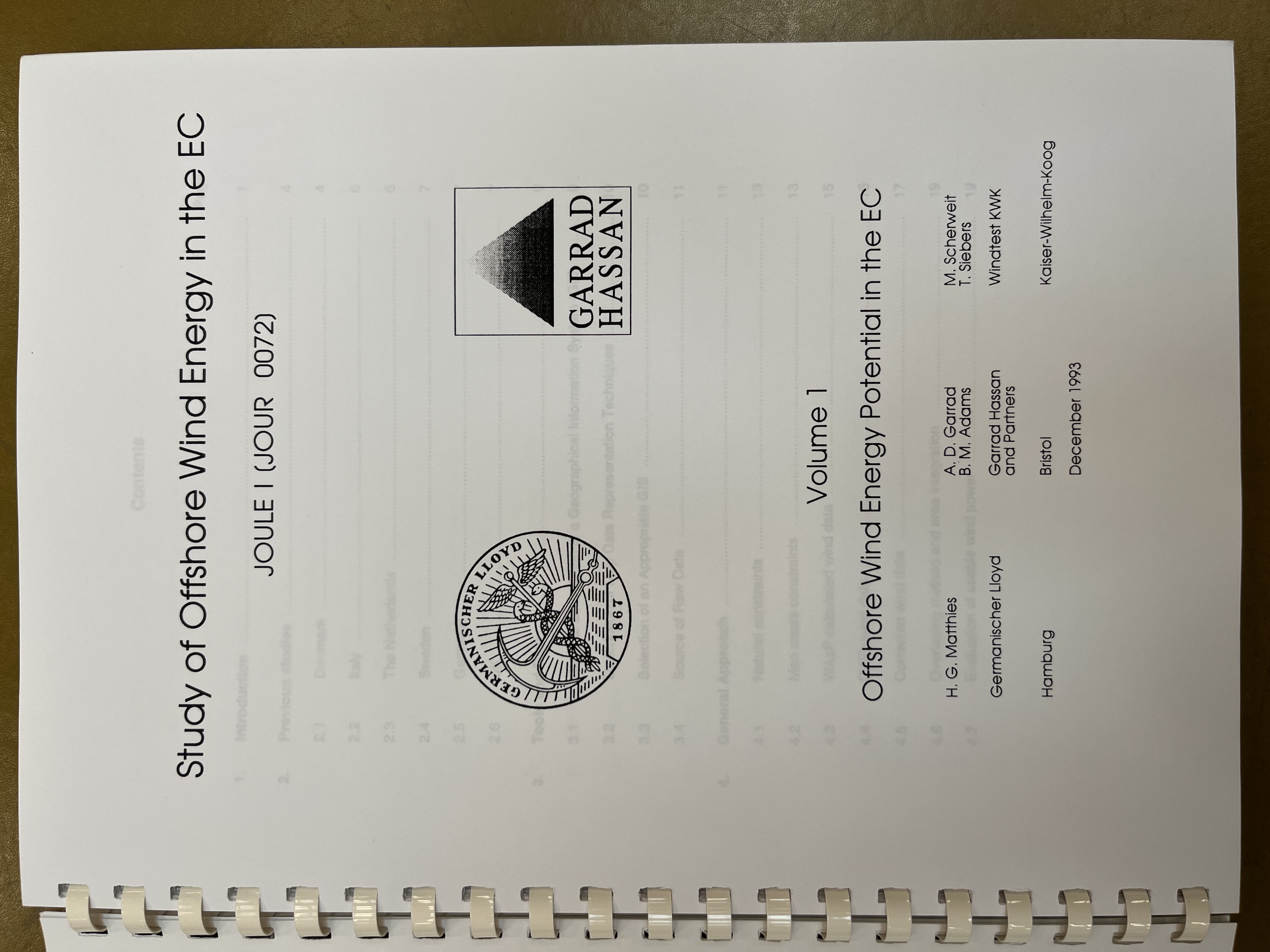
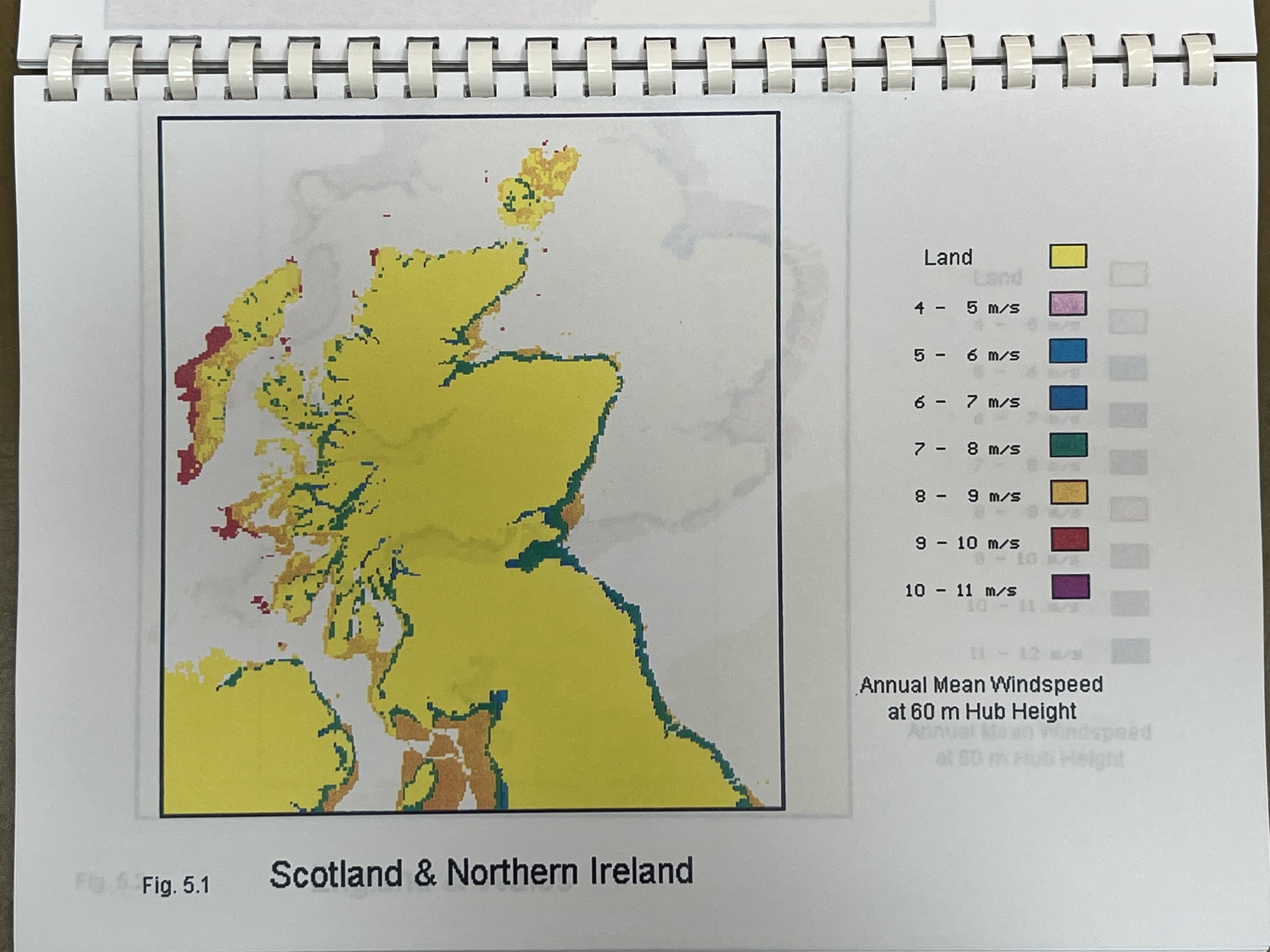
The dated graphics were not a surprise. But there was a surprise in the text of the report: it did discuss Scotland’s share of the United Kingdom resource.
Scotland was not broken out in the data compiled by the 1993 study itself, but the report included a discussion of an earlier report11The UK Offshore Wind Power Resource. Milborrow, D.J.; Moore, D.J.; Richardson, N.B.K. and Roberts, S.C. Proc. 4th International Symposium on Wind Energy Systems. Published in 1982 (published in 1982!) which was said to be “a very good summary” of the United Kingdom resource. It did break out Scotland, and the results were summarised in this table:
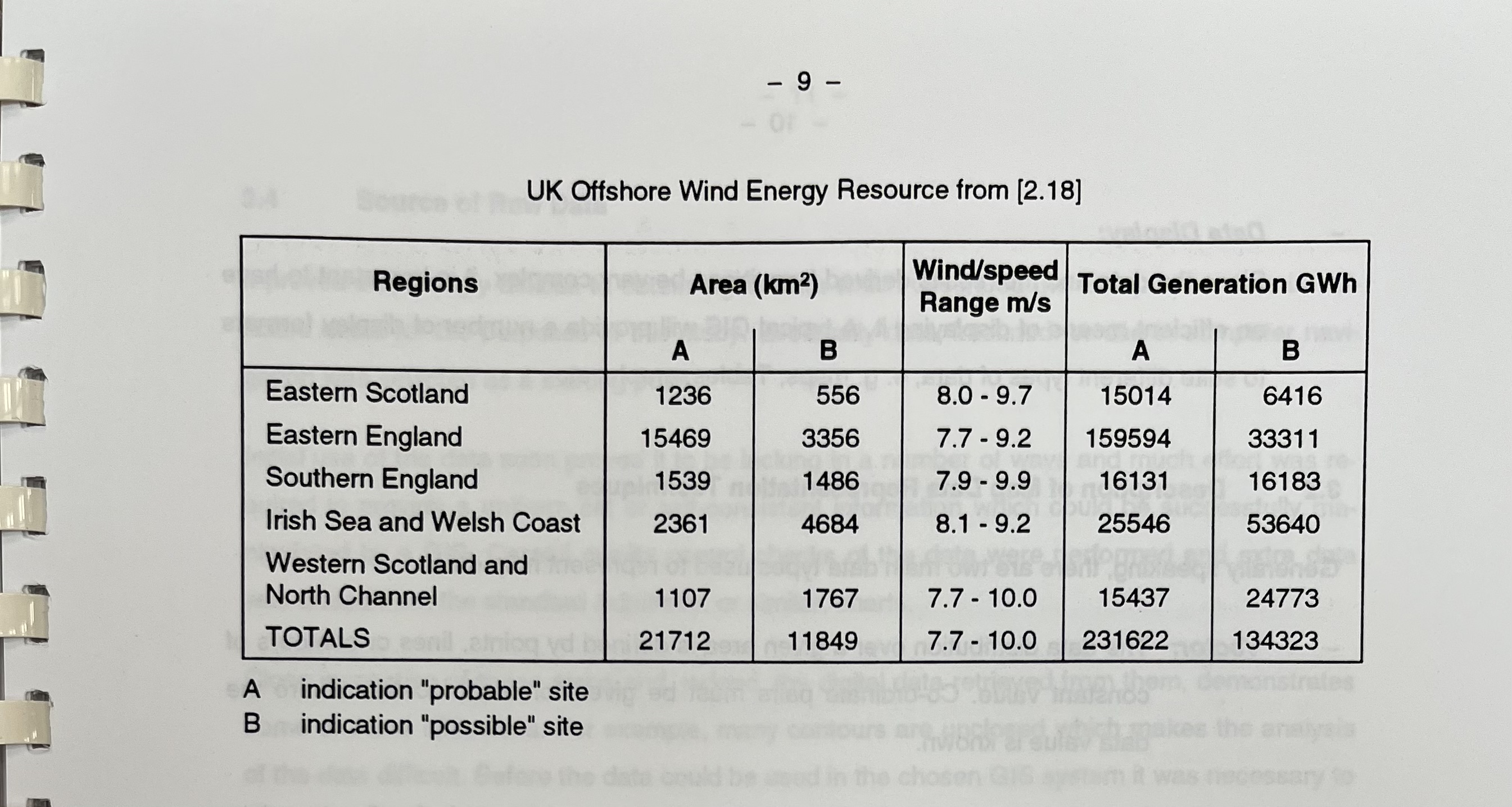
Add up the "probable" and "possible" figures, and the two Scottish regions account for 17% of the United Kingdom total (62 TWh out of 366 TWh).
Never mind 25% of Europe’s potential resource - the very report which the Scottish Government relied upon to substantiate that claim actually cited evidence (albeit very old evidence) that Scotland had only 17% of the UK’s potential resource.
So how did the Scottish Government try to justify its 25% claim?
Numerators and Denominators
If you are going to use two separate studies - one for the subregion and another for the wider region - it’s vitally important that the resource is measured on a consistent basis across both.
Measuring potential resource is about much more than simply knowing wind speeds and the total area of your seabed. A meaningful estimate of potential generating capacity depends on various constraints, including technical and environmental factors.
These constraints include assumptions about the size of turbines, how closely together they can be packed, the maximum feasible water depths, the minimum distance from the shoreline, sensitivities to ecological interests, and to the needs of other users of the ocean.
Environmental constraints are not going to change much over time, but technical constraints certainly will. The size of turbines and the depths of water in which it’s possible to install them have both increased markedly since the early years of the offshore wind industry.
So, a critical question: did the two studies - conducted 8 years apart - apply consistent constraints?
If you wanted to overstate Scotland’s share of the European resource, you would need to inflate the numerator of your fraction relative to the denominator.
The constraints implicitly applied to the denominator by the Scottish Government were actually a mixture of the constraints in the original 1993 study, and some additional ones from the 1999 report, which relied on the 1993 data.
It’s immediately suspicious that the Scottish Government took its numerator from the later report. Examining the 1993/1999 and 2001 constraints side by side, that suspicion is confirmed.
The 2001 constraints included all the resource at least 5km from the shoreline in waters up to 30m deep, and assumed a turbine density of 8 MW per square km.12Scotland’s Renewable Resource 2001 – Volume I: The Analysis (page 44 of pdf). Garrad Hassan and Partners Limited. Published by the Scottish Government. 7th December 2001
The 1993/1999 constraints only included waters up to 20m deep, and assumed a turbine density of 6 MW per square km. Furthermore, they excluded anything further than 30km from the shoreline, and included only 10% of the resource 0-10km from the shoreline, and 50% of the resource 10-30km from the shoreline.13Wind Force 10 – A blueprint to achieve 10% of the world’s electricity from wind power by 2020 (page 18 of pdf). European Wind Energy Association, Forum for Energy and Development, and Greenpeace International. Published October 1999
The constraints applied in 2001 were very different to those applied in 1993/1999. This is quantitatively clear, and the qualitative descriptions of the respective constraints emphasise the point:
2001 (Scotland - the numerator)
Unlike onshore wind, cells were not grouped into wind farms as such an exercise was considered to be highly speculative in the context of limited operational experience. The resource estimates are therefore higher than might be the case if public acceptability and other technical, environmental and navigational constraints were considered.
1993/1999 (European total - the denominator)
For the purposes of this report, BTM Consult have taken a very conservative approach of the potential shown in Table 3-2 in order to come up with a likely “exploitable resource” which can be recognised as available for development within the next two to three decades and with the technology likely to be in use during that period.
The numerator constraints were expansive and the authors of that report were careful to acknowledge they had ignored many real world factors. The denominator constraints were the opposite: “very conservative”.
The Scottish Government Calculation
The precise details of the Scottish Government calculation are described in an FOI response published on 11th May 2022.14UK's offshore wind capacity: EIR release. Published by the Scottish Government, 11th May 2022 It was possible to piece these details together from the March 2021 FOI response, but the second FOI confirmed beyond doubt the basis of the Scottish Government calculation.
The numerator was taken from this table, contained in the Executive Summary of the 2001 report:15Scotland’s Renewable Resource 2001 – Executive Summary (page 8 of pdf), Garrad Hassan and Partners Limited. Published by the Scottish Government. 7th December 2001
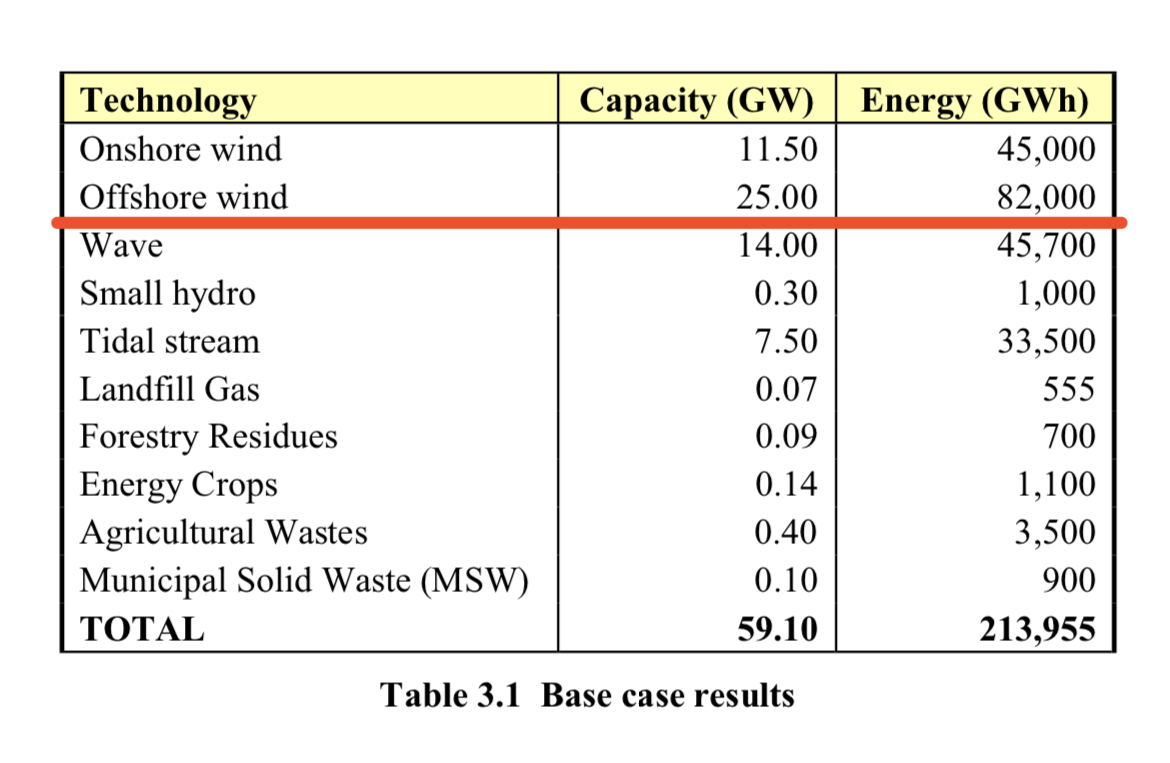
It said that Scotland’s potential offshore wind resource was 25 GW and could produce 82,000 GWh of annual output (or 82 TWh). The implied load factor is:
82,000 / (365 x 24 x 25) = 37%
And the denominator was derived from this table in the 1999 report:16Wind Force 10 – A blueprint to achieve 10% of the world’s electricity from wind power by 2020 (page 18 of pdf). European Wind Energy Association, Forum for Energy and Development, and Greenpeace International. Published October 1999

Notice that the table is sourced to a 1995 report, which we have already established was first published in 1993.
Some maths is required to apply the constraints to the data in the table. Recall the constraints included waters only up to 20m deep, so we are concerned with the figures underlined in red.
10% of the resource 0-10km from the shoreline is:
0.1 x 1,121 = 112.1 TWh
50% of the resource 10-30km from the shoreline is:
0.5 x (1,523 - 1,121) = 201 TWh
And the total constrained figure for Europe is:
112.1 + 201 = 313.1 TWh
The difference between the 313.6 TWh number mentioned in the May 2022 FOI response and the 313.1 TWh figure derived above is presumably just a rounding issue.
313.6 TWh of annual output was converted into capacity terms by assuming a load factor of 35%:
313,600 / (365 x 24 x 0.35) = 102 GW
A slightly lower load factor for Europe as a whole than for Scotland makes sense, as wind speeds are more consistent in the Northern North Sea.
Bizarrely, the Scottish Government was seemingly unable to figure out the above steps in the calculation. The May 2022 FOI response included this remark:
“While our aim is to provide information wherever possible, in this instance we do not have some of the information you have requested in relation to the data and analysis used to achieve this figure. Unfortunately Scottish Government does not hold a record of the formulae used to arrive at this figure.”
Finally, the Scottish Government calculation is:
25 / 102 = 24.5%
But the numerator and denominator are completely inconsistent. The numerator is massively overstated based on the same constraints used in the denominator.
An aside
To illustrate just how absurdly constrained the Scottish Government denominator is, consider this: the 1982 study, cited in the 1993 report, said the UK’s potential offshore wind resource was capable of generating 366 TWh of output per annum.
The Scottish Government is using a denominator (for the whole of Europe) which is smaller than an estimate made 40 years ago for only the UK.
It’s worth pausing to look again at this table:

Look at the raw figures underlined in red, and look at what the constraints did to them: a plausible 1,523 TWh was shrunk all the way down to 314 TWh.
The extremely conservative constraints applied to the denominator are the critical factor in all of this. They radically shrink the potential European resource, thus radically (and wrongly) inflating Scotland’s share.
The EC in 1993
And there is a further twist to the story. Notice the title of that 1993 report: Study of Offshore Wind Energy in the EC. The EC in 1993 included only 12 countries, one of which was land-locked Luxembourg. So the European total in that report was in fact the total of only 11 European countries, and did not include Norway, Sweden, or Finland.
As well as inflating the numerator relative to the denominator by applying inconsistent constraints, the Scottish Government also shrank the denominator by using an absurdly outdated and restrictive definition of Europe, which excluded many European countries with very substantial offshore wind resources.
What did the Scottish Government know about this?
The initial January 2021 FOI response did not include all of the information necessary to piece this story together. Follow up FOIs were required to complete the jigsaw. And one final FOI request provided perhaps the most shocking piece of all.
It’s important to note that none of the FOI responses actually acknowledge that the 25% figure is incorrect.
Freedom of information can be used to ask the Scottish Government to release its own internal deliberations on previous FOI requests. That’s what the final FOI did.17Internal correspondence request: FOI release. Published by the Scottish Government. 5th October 2022 The conversations amongst government officials about if, and how, they could justify the 25% claim are extremely revealing. Some excerpts:
“Whilst the 25% figure has been used in the past, we tend not to use this anymore. It has proved very difficult to source.”
[9th October 2020]
“the 25% estimate has never, to my knowledge, been properly sourced”
[20th October 2020]
“Other than our recent exchanges on this request, of course, I’ve nothing to offer – my search of the G drive having unfortunately yielded up nothing more on the [redacted] study in 2001 and why it should have been associated with the “25%” estimate.”
[12th January 2021]
“Yes we did recycle those figures quite robotically without really checking them."
[18th January 2021]
The Scottish Government clearly knew the 25% figure was wrong. Unless it too had been delving into the archives of the National Library of Scotland, it may not have known the full story. But it knew people were asking difficult questions.
And yet after the conversations amongst officials from which the above quotes are taken, the claim continued to appear in Scottish Government publications. This is not how the civil service is supposed to work. Data which officials know is unjustifiable should never be allowed into government publications to be used as political propaganda.
It was only after our final FOI request - which forced the Scottish Government to make public the conversations which exposed internal disquiet - that the claim was finally dropped: it was conspicuously absent from Building a New Scotland - A stronger economy with independence - the Scottish Government's latest economic prospectus for independence, published last month.18Building a New Scotland - A stronger economy with independence. Published by the Scottish Government. 17th October 2022
But many SNP politicians did not get the memo. The 25% claim was repeated on multiple occasions in the House of Commons just last week, during an opposition day debate on Scottish Independence and the Scottish Economy.19Scottish Independence and the Scottish Economy. Hansard. 2nd November 2022
So… what is Scotland’s share of Europe’s potential offshore wind resource?
The Scottish Government was a key member of the Offshore Valuation Group: an informal collaboration of government and industry organisations who came together to commission a report: A valuation of the UK’s offshore renewable energy resource, which was published in 2010.20The Offshore Valuation - A valuation of the UK’s offshore renewable energy resource. Boston Consulting Group for the Offshore Valuation Group. Published by the by Public Interest Research Centre in 2010
That report included a breakdown of the UK’s potential offshore wind resource by nation:
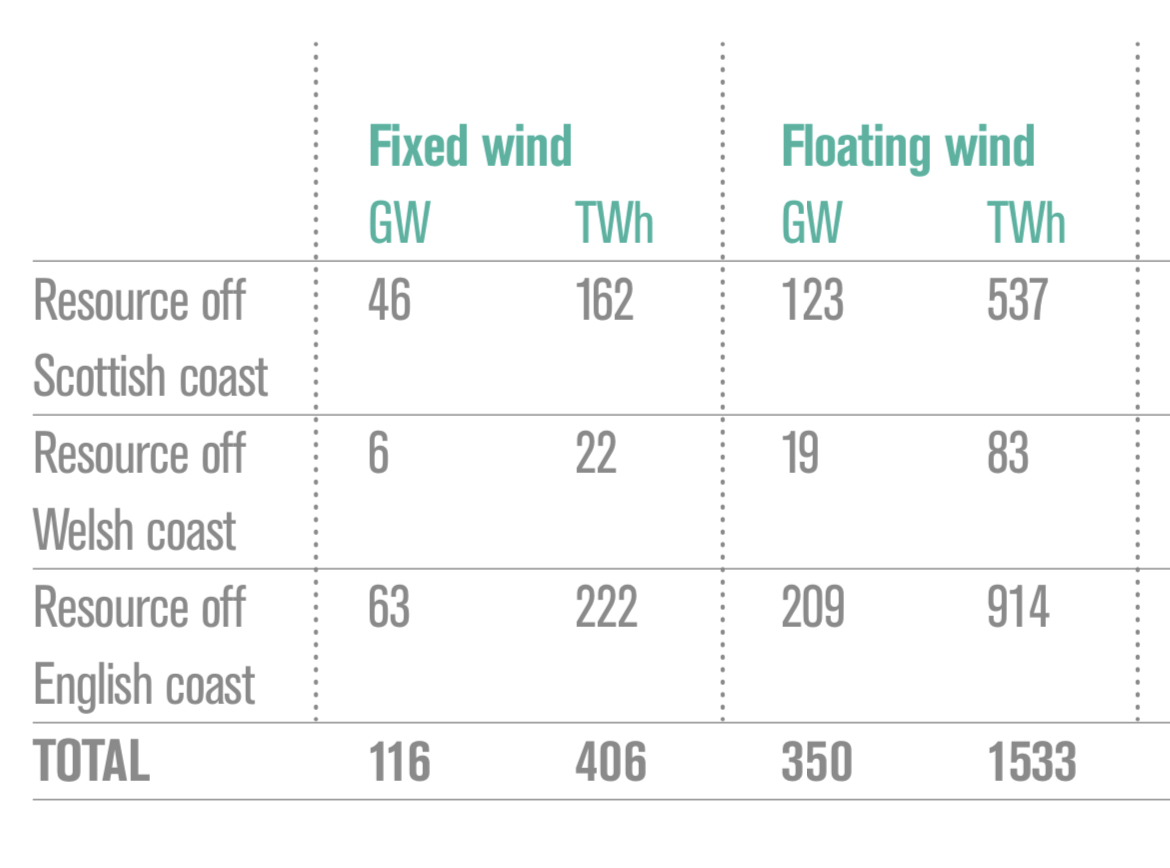
So, in 2010, the Scottish Government definitely had a robust (and, at the time, bang up to date) estimate which put Scotland’s share of the potential UK resource (fixed plus floating) at:
(46 + 123) / (116 + 350) = 36%
Unsurprisingly, this is quite a bit higher than the 17% share cited in the 1993 report. Technological improvements over the intervening years have had a greater impact in Scotland, and much more of the difficult resource is now viable.
In 2009, the European Environment Agency published a report providing a Europe-wide resource assessment of onshore and offshore wind potential.21Europe's onshore and offshore wind energy potential. Published by the European Environment Agency in 2009
It estimated the potential European offshore wind resource at 30,000 TWh, and included the chart below showing the distribution of the resource across different countries:
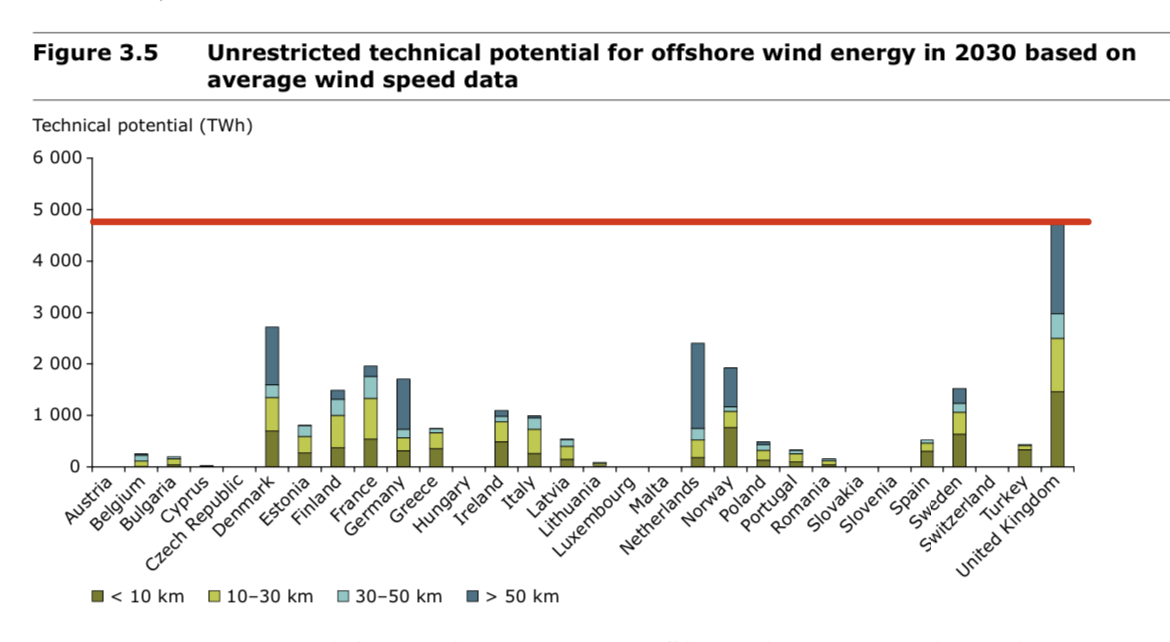
The United Kingdom’s potential resource is 4,800 TWh (interpolated from the chart) and therefore the UK’s share of the European resource is:
4,800 / 30,000 = 16%
This is obviously inconsistent with Scotland having a 25% share, and was readily available to the Scottish Government in 2010. Notice also the substantial resource attributable to Norway, Sweden, and Finland - countries excluded from the Scottish Government’s implicit definition of Europe. The EEA report defined Europe to be the then EU-27, plus Norway, Switzerland, and Turkey - a much more expansive and sensible definition.
So what the Scottish Government should have said in 2010 was that Scotland had about 6% (36% of 16%) of the potential Europe-wide offshore wind resource.
It’s important to note that this does not repeat the Scottish Government’s mistake of using an inconsistent numerator and denominator. The fractions are from different reports, but each fraction in the above calculation is internally consistent.
The Offshore Valuation Group report also includes a useful explainer on different ways of measuring resource:
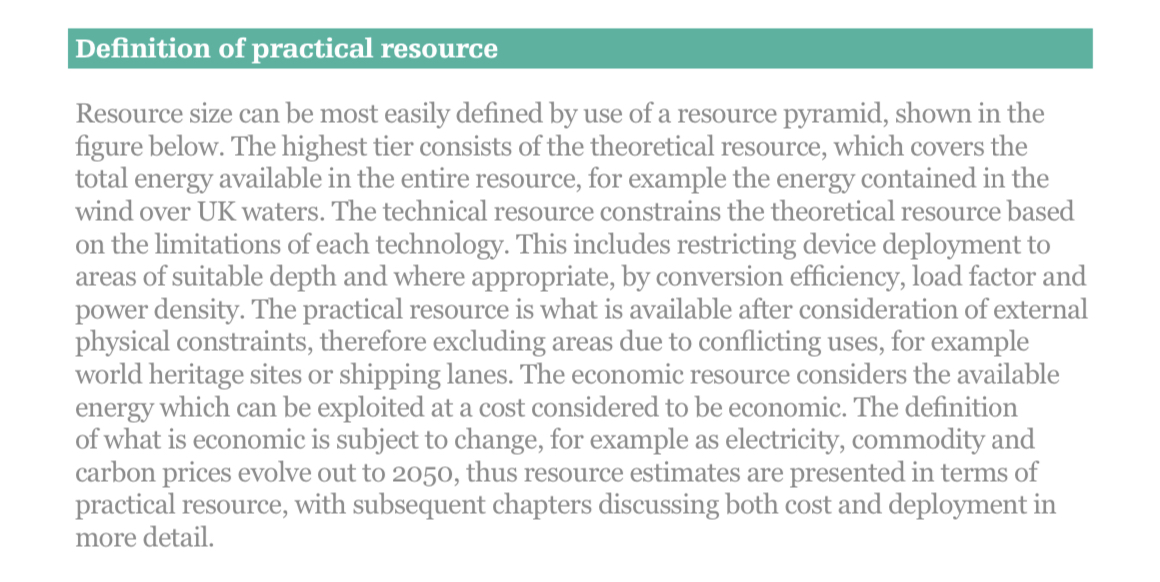
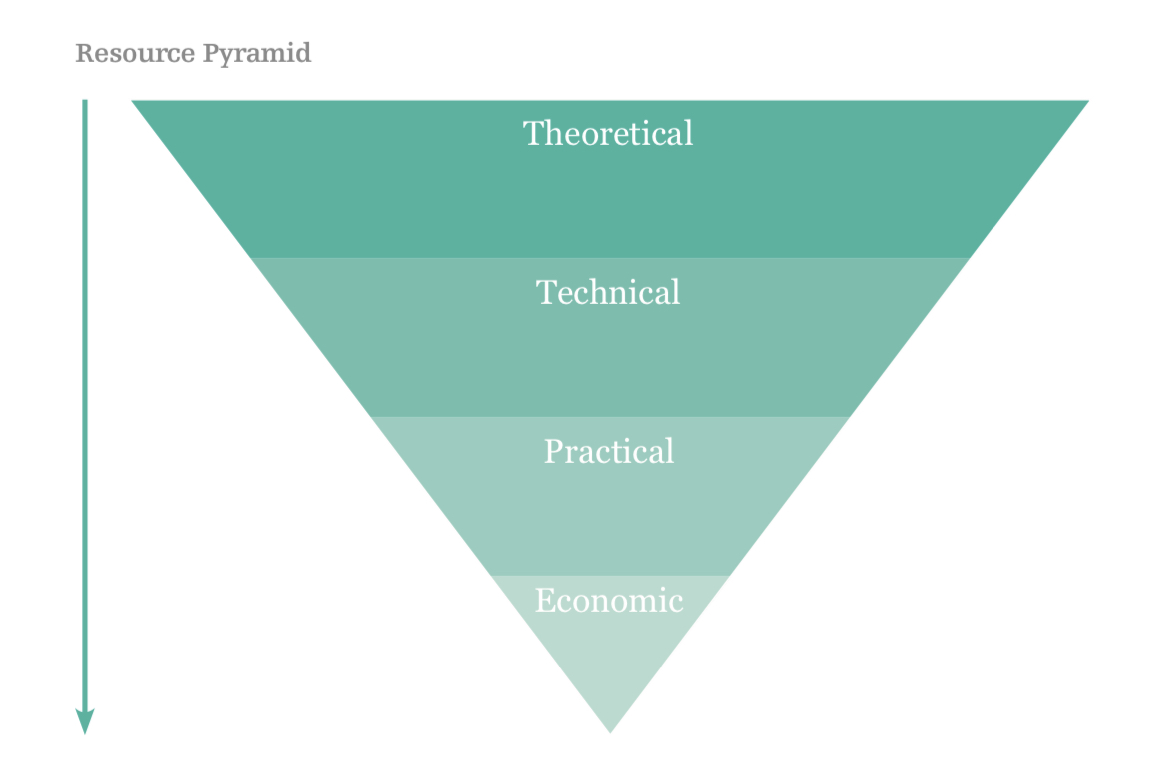
Thus far, we have been discussing resource estimates somewhere around the boundary between technical and practical.
An economic resource estimate for Europe can be found in a 2019 report by BVG Associates (a respected renewables industry consultancy) commissioned by WindEurope (a trade body representing the wind industry in Europe).22Our energy, our future - How offshore wind will help Europe go carbon-neutral. BVG Associates for WindEurope. Published November 2019
It estimated how much offshore wind capacity Europe would require to achieve net-zero, and then analysed how that capacity would be most cost effectively distributed.
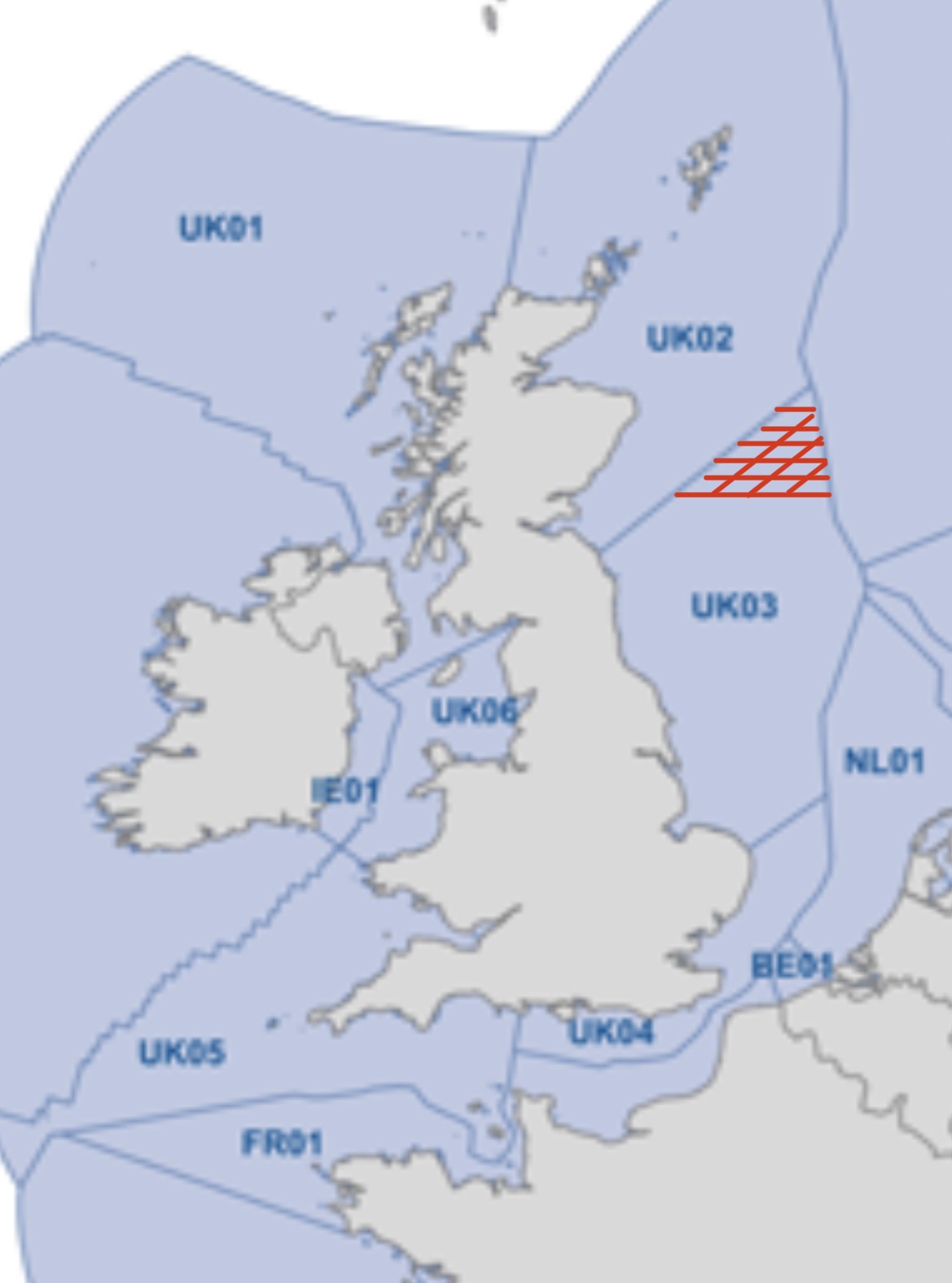
It found that 2.2% of the European capacity would be in sea regions UK01 and UK02 in the map above, which is certainly all attributable to Scotland. Sea region UK03 is mostly attributable to England, but the location of the maritime border means the area shaded in red belongs to Scotland. If we generously attribute 30% of the capacity allocated to region UK03 to Scotland, and add it to the totals of UK01 and UK02, Scotland’s share of the European total comes to 4% (18 GW out of 450 GW).
Scotland currently has around 2 GW of operational offshore wind, and a further 3.75 GW of projects are consented or under construction.23UK's offshore wind capacity: EIR release. Published by the Scottish Government. 11th May 2022 The ScotWind leasing round awarded 25 GW of option agreements (plus an additional 3 GW focussed on hydrogen production). But the ScotWind totals will not, in practice, be constructed. This was acknowledged in an FOI response published by the Scottish Government in April 2022, which said:24Correspondence regarding ScotWind allocation: EIR release. Published by the Scottish Government. 14th April 2022
“25GW is the combined current ambition of the projects proposed by developers who have secured rights to the seabed at this stage of the leasing process. The figure holds no status beyond that. None of those projects have been approved by the Scottish Ministers.”
And went on to add:
“There will now be a process for determining what can be consented in terms of projects. This process will be predicated on assessing the environmental impacts of each project on its own merits. However, it will take the SMP as its guiding planning framework and operate in light of the impacts assessed from an upper scenario of 10GW outlined in the SMP and applied in environment assessments.”
SMP refers to the Sectoral Marine Plan which the Scottish Government published in October 2020.25Sectoral marine plan for offshore wind energy. Published by the Scottish Government. 28th October 2020
It stated:
“This Plan sets out the spatial footprint for the current cycle of ScotWind leasing and a maximum potential capacity under this leasing round of up to 10 GW.”
So, if we add up operational (2 GW), consented and under construction (3.75 GW), and a realistic upper limit for the ScotWind total (10 GW) we get to a total of 15.75 GW. And if we assume the Sectoral Marine Plan is revised upwards (which is possible) the 18 GW attributed to Scotland in the BVG Associates report does not look unreasonable.
The map below from the same report also makes an important point. Electricity is very expensive to transmit over large distances, so inevitably the economically viable resource is concentrated as close as possible to where population density is greatest. This, combined with the fact that much of Scotland’s technical potential is in floating wind (which is more expensive than fixed), explains why Scotland’s share on an economic basis is somewhat lower than its technical/practical potential.
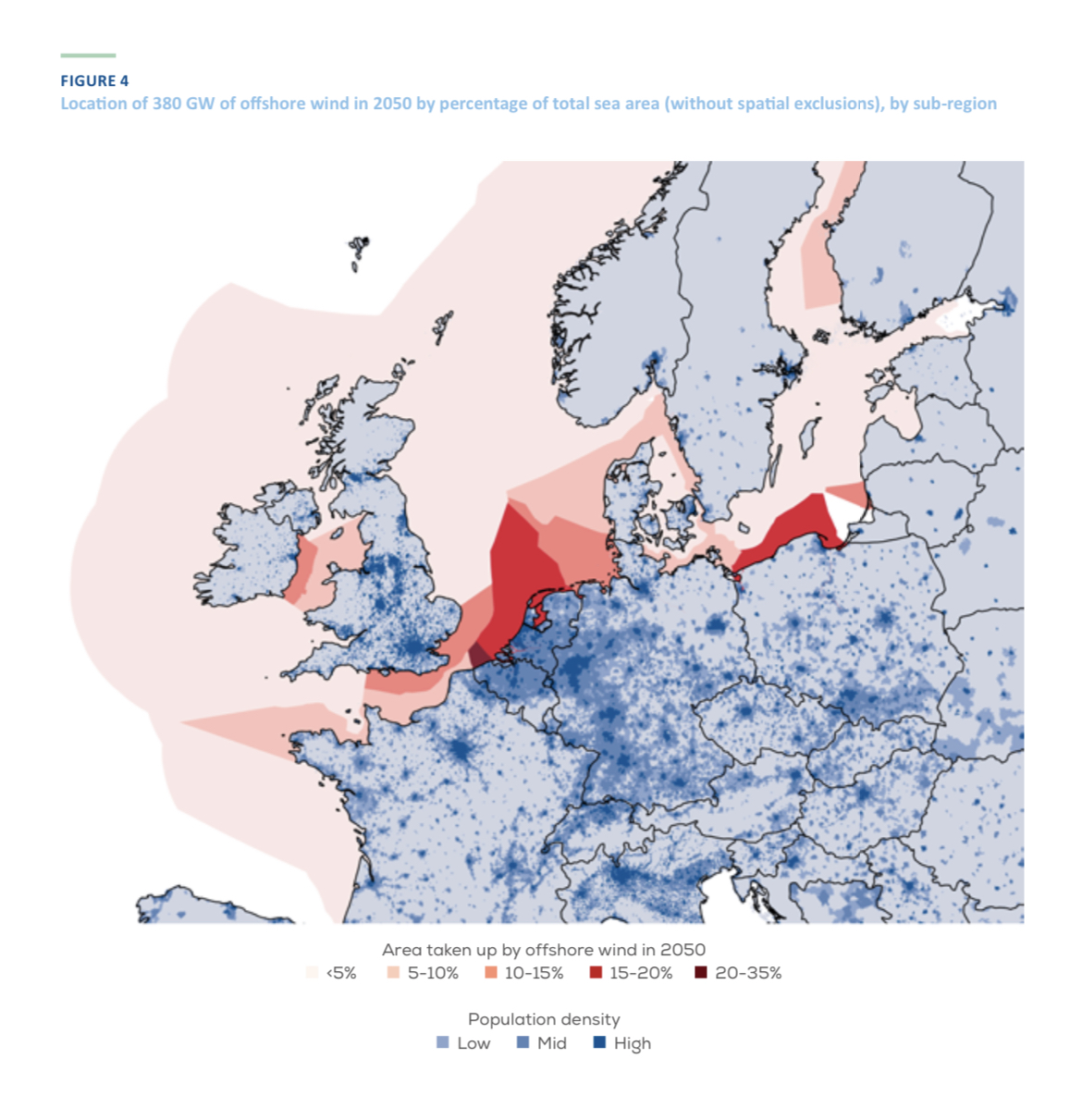
But it’s very clear that whichever way you cut it, Scotland’s share of the total European resource is somewhere around 4-6%, and nowhere even close to 25%.
Please log in to create your comment